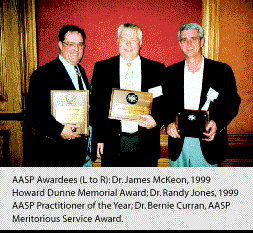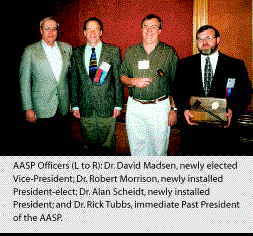1999 AASP Annual Meeting
Annual Meeting |
The gateway to the West became a great crossroads city for the AASP Annual Meeting at the Adam’s Mark Hotel, St. Louis on February 27-March 2, 1999 with:
- 536 veterinary registrants,
- 77 students,
- 16 officers and directors,
- 157 speakers,
- 12 press,
- 4 honored guests, and
- 151 technical table representatives.
Dr. Alan Scheidt, Program Chairman, organized speakers, topics, and presentations that emphasized the 1999 AASP theme of "Swine Practice, Pork, and the Media." The meeting began with 14 preconvention workshops on Saturday and Sunday. Sunday also included three industrial partner sessions and a student seminar with 15 veterinary student presenters. Monday’s general session featured 15 speakers. A special session on Monday afternoon focused on the timely topic of the current economic conditions within the swine industry. Tuesday rounded out the meeting with 30 presentations in three concurrent sessions.
AASP Board of Directors
President Rick Tubbs convened a meeting of the AASP Board of Directors on Saturday, February 27, 1999. AVMA President Richard Swanson and AVMA President-Elect Leonard F. Seda were welcomed and addressed the board. Three newly elected board members were announced: Dr. Andy Holtcamp, Clinton, North Carolina (District 2), Dr. Larry Firkins, Mahomet, Illinois (District 5), and Dr. Keith Wilson, Worthington, Minnesota (District 9).
Dr. Barry Wiseman from the Nextran Corporation reported to the board on the major challenges of xenotransplantation and use of swine tissue. Nextran requested human blood samples from veterinarians attending the AASP Annual Meeting for a serological survey of swine diseases. Nextran pledged a generous $75 contribution to the AASP Foundation for every member who donated blood at the meeting. This cooperation resulted in 469 samples being drawn at the meeting and a contribution of $34,700 to the Foundation.
Dr. Paul Sundburg, NPPC, described the Accelerated Pseudorabies PRV Eradication Program. He also explained the FDA-proposed framework for evaluating and assuring human safety from new antimicrobial animal drugs intended for use in food-producing animals.
Mr. John McNutt, President-Elect of the NPPC, addressed the board regarding the partnership of the AASP and the NPPC. A new AASP/NPPC biosecurity working group with research and educational goals was described by Dr. Dave Pyburn, Director, Veterinary Science, NPPC. Dr. Jim McKean distributed a draft of a good production practices audit report, prepared by the AASP Food Safety Committee.
Preconvention workshops
Technology and business issues were addressed on Saturday afternoon and Sunday morning in five workshops: "The World Wide Web: Learning the Tools and Getting Results," "Building Technologies/Finishing Concepts," "Applying Statistics to the Real World," "NPPC Standards for Production and Financial Records," and "Using Digital Image Technologies in Your Practice."
Four public relations topics were discussed in workshops: "How to Talk to the Media: Electronic, Print, and Radio," "Communication for Business Success," "Serving the Traditional Swine Producers," and "Swine Practice, Pork, and the Media: An International Perspective."
The final five workshops emphasized health and production with "Judicious Antimicrobial Use," "Control of Reproduction in the Female Pig," "PigCHAMP, Problem Solving," "Pathology: Disease Diagnosis and Discussion," and "Nutrition: Measuring and Applying Lean Growth Curves."
Student participation
Roche Animal Nutrition and Health again sponsored the 15 student presentations and honored each student with a $500.00 stipend and a leather portfolio. Students from the University of Georgia, University of Guelph, University of Illinois, Iowa State University, Kansas State University, Michigan State University, University of Minnesota, Mississippi State University, North Carolina State University, University of Pennsylvania, and the University of Wisconsin participated.
Industrial Partner sessions and technical show
Drs. Steve Sornsen, Paul Runnels, and Paul Sundberg chaired three industrial partners sessions on Sunday afternoon. New technologies, products, and services were reviewed by 49 speakers representing 33 companies and organizations. Sunday afternoon and all day Monday the participants were able to interact with representatives from 53 companies related to, and that provide products and services to, the pork industry.
Howard Dunne Memorial Lecture
 Dr. Larry Rueff presented the 1999 Howard Dunne Memorial
Lecture entitled "Swine Veterinary Practice: Entering the
21st Century." Dr. Rueff gave a thought provoking
and entertaining presentation in which he compared swine production
and swine practitioners of the past with today’s dynamic and rapidly
changing industry. He discussed the technological breakthroughs
that have occurred during his 20 years of swine practice and the
impact these new technologies have had on the swine industry.
He described the collateral impact the changing
Dr. Larry Rueff presented the 1999 Howard Dunne Memorial
Lecture entitled "Swine Veterinary Practice: Entering the
21st Century." Dr. Rueff gave a thought provoking
and entertaining presentation in which he compared swine production
and swine practitioners of the past with today’s dynamic and rapidly
changing industry. He discussed the technological breakthroughs
that have occurred during his 20 years of swine practice and the
impact these new technologies have had on the swine industry.
He described the collateral impact the changing
swine industry has had on the veterinary profession and how swine
practitioners have expanded the services they deliver to their
clients. In closing, Dr. Rueff acknowledged the anxiety that changes
can cause but he said "I see it as an exciting time to be
a swine veterinarian!"
General session
Dr. Stephen Sundlof, director of the Center for Veterinary Medicine, gave a regulatory perspective of antibiotic resistance. This was followed by a paper presented by Dr. Peter Davies, "Foodborne Pathogens and Pork Production: What is Our Achilles Heal?" Dr. Davies described the major areas of concern with pork safety and offered some practical solutions. Dennis Avery, director of Global Food Issues, Hudson Institute, (who was also the banquet speaker), gave a "Rest of the Story" presentation, titled "Antibiotic Resistance and Public Policy." He emphasized that prudent use of antibiotics in production animals was in fact a positive rather than a negative. He challenged the audience to tell our story to the general public. He said we must advertise the good news of livestock production. Karen Kalish of Kalish Communications gave a stimulating presentation "How to Talk to the Media: Televisions, Radio, and Print." She presented real life situations and gave tips on how to tell your story rather than respond to questions a reporter thinks might make a headline story. The general session also included sessions on classical swine fever, porcine reproductive and respiratory syndrome, and the economic conditions in the United States pork industry.
Concurrent sessions
On Tuesday morning attendees were given a wide choice of presentations. Serology, vaccinology, current research, disease control, and disease diagnosis were the highlighted topics in the three concurrent sessions.
Awards
 Dr. Jim McKean, extension veterinarian and interim
director of the Iowa Pork Industry Center, received the Howard
Dunne Memorial Award. Dr. McKean is a Past President of the AASP
and the American Association of Extension Veterinarians. He is
recognized both nationally and internationally for the many contributions
he has made to the swine industry and swine producers. The Meritorious
Service Award recipient was Dr. Bernie Curran, a swine practitioner
from Eldridge, Iowa. He was recognized for his tireless service
to the AASP, AVMA, and the swine industry. Dr. Randy Jones, Kinston,
North Carolina was named 1999 Swine Practitioner of the Year in
recognition of his outstanding service to his clients and the
veterinary profession. Letters of support from his clients praised
Dr. Jones as a swine practitioner, a family man, and a community
leader. Fortunately, family members of all three awardees were
able to be present to help celebrate the accomplishments of these
three swine practitioners.
Dr. Jim McKean, extension veterinarian and interim
director of the Iowa Pork Industry Center, received the Howard
Dunne Memorial Award. Dr. McKean is a Past President of the AASP
and the American Association of Extension Veterinarians. He is
recognized both nationally and internationally for the many contributions
he has made to the swine industry and swine producers. The Meritorious
Service Award recipient was Dr. Bernie Curran, a swine practitioner
from Eldridge, Iowa. He was recognized for his tireless service
to the AASP, AVMA, and the swine industry. Dr. Randy Jones, Kinston,
North Carolina was named 1999 Swine Practitioner of the Year in
recognition of his outstanding service to his clients and the
veterinary profession. Letters of support from his clients praised
Dr. Jones as a swine practitioner, a family man, and a community
leader. Fortunately, family members of all three awardees were
able to be present to help celebrate the accomplishments of these
three swine practitioners.
Business breakfast
 Dr. Alan Scheidt, Raleigh, North Carolina was installed
as President of AASP on Tuesday, March 2, by outgoing President,
Dr. Rick Tubbs. Dr. Bob Morrison, St. Paul, Minnesota became President-Elect
and Dr. David Madsen, Columbus, Nebraska, was elected Vice President.
Dr. Alan Scheidt, Raleigh, North Carolina was installed
as President of AASP on Tuesday, March 2, by outgoing President,
Dr. Rick Tubbs. Dr. Bob Morrison, St. Paul, Minnesota became President-Elect
and Dr. David Madsen, Columbus, Nebraska, was elected Vice President.
The 31st Annual AASP meeting will be held at the Westin Hotel, Indianapolis, Indiana, March 11-14, 2000.
This page last updated .